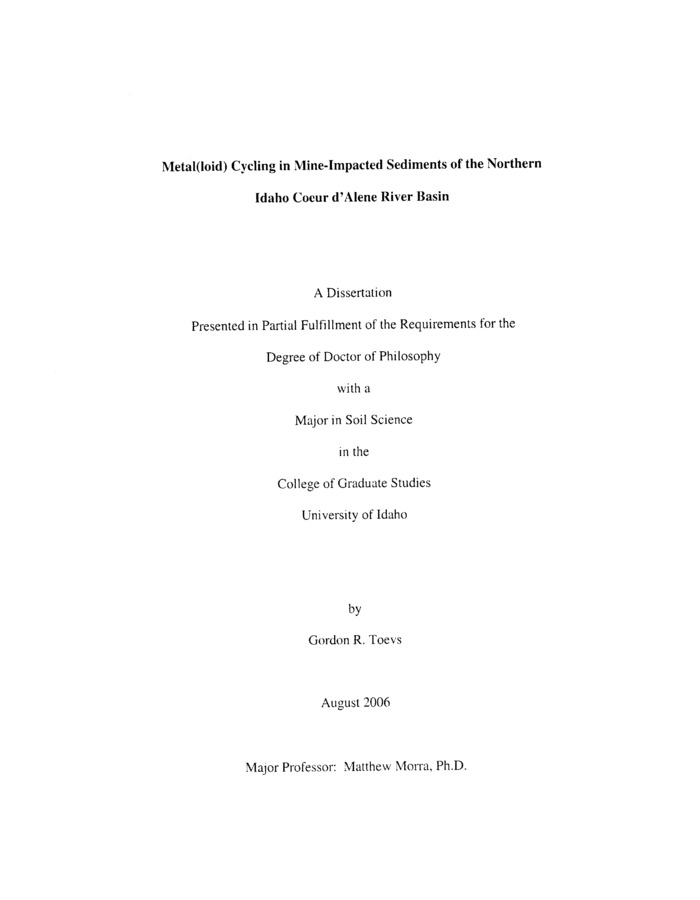PDF
Metal(loid) cycling in mine-impacted sediments of the northern Idaho Coeur d'Alene River Basin Item Info
- Title:
- Metal(loid) cycling in mine-impacted sediments of the northern Idaho Coeur d'Alene River Basin
- Authors:
- Toevs, Gordon R.
- Contributors:
- Idaho Water Resources Research Institute; IWRRI
- Date:
- 2006-08
- Description:
- Mining activity along the South Fork of the Coeur d'Alene (CDA) River in northern Idaho has resulted in mine tailings enriched in Pb, As, Ag, Sb, Hg, Cd, and Zn that have contaminated broad areas of the CDA River floodplain and Lake CDA. Without a clear understanding of contaminant redistribution, tailings transport, and metal cycling within this region, sound management decisions to protect environmental quality are difficult. Our objective was to better define the biogeochemical reactions controlling toxic metal cycling within sediments of Lake CDA and wetlands in the Basin. Sediment from contaminated sites in the Lake and Basin wetlands were collected as cores and interstitial water samples obtained using equilibrium dialyzers. Solid phase associations of Fe, S, and As were probed using x-ray absorption (XAS) spectroscopy. In Lake CDA sediments we identified a gradient from oxic conditions at the sediment-water interface to anoxic conditions below 10 cm, thus creating a dynamic redox environment that controls metal(loid) sorption and solubility. The oxic cap at the sediment-water interface traps many of the contaminant metal(loids) decreasing their flux into the overlying water column. However, flood events bury the oxic cap materials transitioning them to asuboxic zone in which reductive dissolution of the oxides releases metal(loid)s into the sediment interstitial water. High Fe:S ratios inhibit the formation of metal(loid)-containing sulfide precipitates in the anoxic zone, thus resulting in chronically and acutely toxic concentrations of soluble metals within the sediment interstitial water. In contrast, constantly saturated wetlands within the Basin do not maintain an oxic sediment cap and concentrations of metal(loid)s in sediment interstitial waters are consequently much lower than those in Lake CDA sediments. This series of reactions and processes presents a dilemma for lake management since promoting reduced conditions at the sediment-water interface in Lake CDA is an unacceptable method to decrease pore water metal(loid) concentrations. Decreased soluble metal(loid) concentrations in the sediments will only occur by minimizing the transport of contaminated materials to Lake CDA.
- Subjects:
- heavy metals water pollution mine wastes
- Location:
- Coeur d'Alene Basin
- Idaho County:
- Shoshone County; Kootenai County
- Latitude:
- 47.52
- Longitude:
- -116.56
- Collection:
- Coeur d'Alene Basin
- Source:
- University of Idaho
- Publisher:
- University of Idaho
- Contributing Institution:
- University of Idaho
- Type:
- Text
- Format:
- application/pdf
- Cataloger:
- wbv
- Date Digitized:
- 2012
- Language:
- eng
Source
- Preferred Citation:
- "Metal(loid) cycling in mine-impacted sediments of the northern Idaho Coeur d'Alene River Basin", Idaho Waters Digital Library, University of Idaho Library Digital Collections, https://www.lib.uidaho.edu/digital/iwdl/items/iwdl-cda_toevs_2006.html
Rights
- Rights:
- In copyright, educational use permitted. Educational use includes non-commercial reproduction of text and images in materials for teaching and research purposes. For other contexts beyond fair use, including digital reproduction, please contact the University of Idaho Library Special Collections and Archives Department at libspec@uidaho.edu. The University of Idaho Library is not liable for any violations of the law by users.
- Standardized Rights:
- http://rightsstatements.org/vocab/InC-EDU/1.0/

